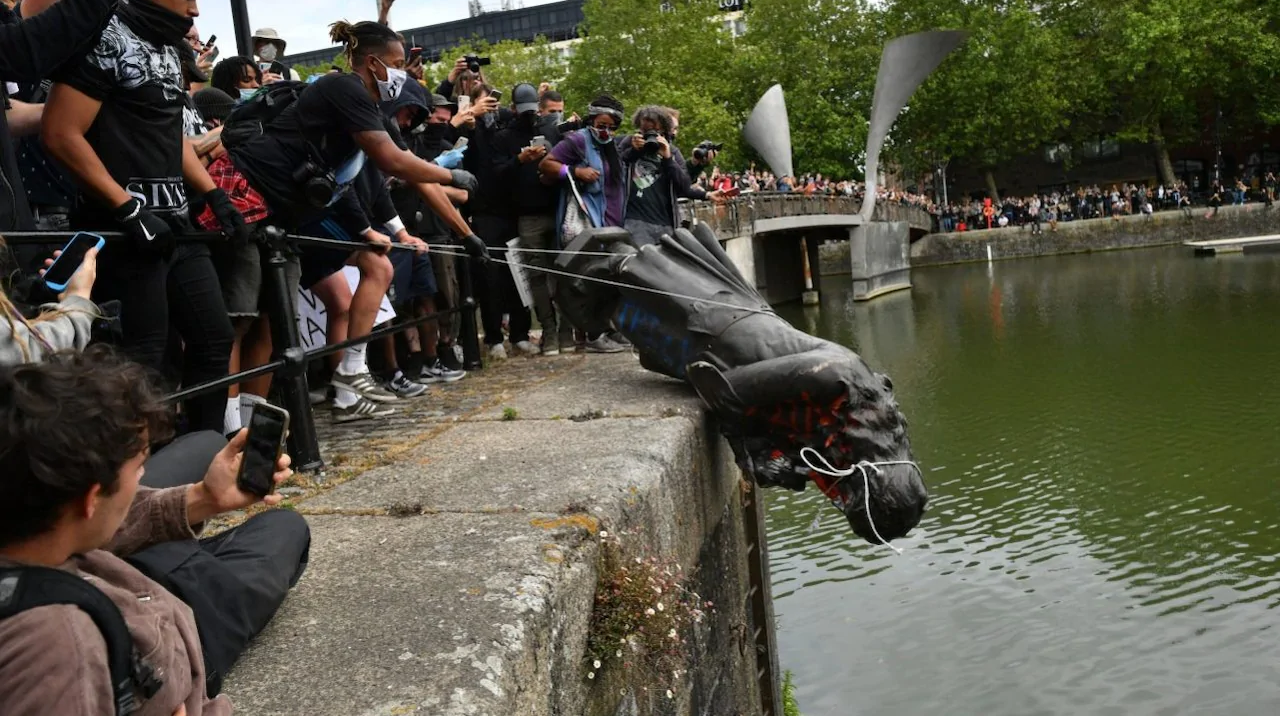
The streets of Britain are littered with monuments glorifying slave owners and colonisers. They sit atop university buildings and outside hospitals, and live on in the names of streets, libraries and schools. They exist in the songs we are taught as children.
As of 7 June 2020, there stands one less statue of a slave trader in Britain. To the sounds of crowds roaring with elation and relief, an 18ft bronze statue of Edward Colston – one of the most notorious slavers in history – was pulled down, dragged across the streets of Bristol and dumped into a river. His statue was thrown from the very harbour where his slave ships used to dock.
We walk past these statues every day, yet few of us even notice them, let alone understand the implications of the people and systems they memorialise. They occupy a strange, dual existence of both invisibility and hypervisibility – they are everywhere, yet we hardly see them. It is only when the descendants of those enslaved and colonised contest the legitimacy of these statues that their significance becomes visible.
The same can be said of our relationship to the history and ongoing existence of coloniality and slavery. The extraction of wealth and brutal exploitation of workers disproportionately in the Global South is the means through which our contemporary economic and political system functions – yet it perpetually goes unnamed and unrecognised. Through this strategic concealment, a system powered by racial terror and inequality can brand itself as a meritocracy, in which violence against racialised people is either incidental or deserved.
The ways in which statues of slave owners and colonisers shape historical remembering is a function of white supremacy. We are told that removing statues ‘erases history’; that colonisers and slave owners were products of their time, so cannot be judged by today’s moral standards. Yet the very existence of these statues erases the histories of the enslaved and colonised, and negates the moral standards of those who revolted against their conditions from the very beginning.
When we look at the statue of British coloniser Cecil Rhodes in Oxford and its accompanying inscription calling him ‘a munificent benefactor’, we do not see the brutalisation and subjugation of Black people that facilitated his ‘benefaction’. When we declare that nobody at the time knew better, we are effacing the struggles of the oppressed, who always knew that what was being done to them was wrong – and who have taught us nearly everything we know about freedom and justice. Both arguments rely on the assumption that Black people are not and never have been people; let alone people who matter.
Indeed, it is no coincidence that slave owners and colonisers often made the building of statues in their name a condition of their ‘donations’ to educational institutions like Oxford University. The propagandistic function of such memorials ensures that only a particular version of history is (literally) set in stone for future generations. So, we end up where we are today – with universities and schools covered in statues of men whose legacies of inequality and oppression is scarcely mentioned in classrooms, so as not to indulge what Michael Gove notoriously dismissed as ‘postcolonial guilt’.
This matters because this history is not confined to the past. Modern Britain was literally built by slavery and colonialism. The Industrial Revolution was financed by money given to slave owners as compensation for the loss of their slaves – their ‘property’ – after abolition. The extraction of oil through occupation literally fuelled the development of European states at the expense of the Global South. Without the sugar harvested by slaves in the Caribbean, and the violent exploits of the East India Company, the paradigmatically ‘British’ cup of tea is nothing but milk and hot water.
It is inaccurate to view colonialism and slavery as simply a matter of legacy. Many of the injustices of today – of massive wealth inequality, climate breakdown and extreme labour exploitation – are rooted in these histories. The displacement and dispossession of poor, racialised people continues, and our global economy is actively driven by coloniality. Our relationship to historical figures like Colston is important because these figures wrote the blueprint for the world we exist in today.
Yet the truth about the role of empire and slavery in building Britain is suppressed in order that the economic priorities of white supremacy can continue. The violent hostile environment policy, for example, relies on the idea that immigrants are not ‘entitled’ to Britain’s resources – a logic that falls apart once you consider that Britain’s development was and continues to be built off the exploitation of people around the world. As Nadine El-Enany argues, this strategic erasure of imperialism from the story of Britain ensures that the spoils of empire continue to be exclusively preserved for white British people.
Statues like that of Edward Colston do not teach us about Britain’s past, nor its existence today. In fact, they stand in the way. They represent an ideology based on the erasure of Black histories and the devaluing of racialised lives. Only by pulling down these statues can we make the space necessary for a meaningful and transformative re-education on how Britain came to be.
Dalia Gebrial is an academic and commentator. Her recent edited volume, Decolonising the University, was published in 2018 with Pluto Press.